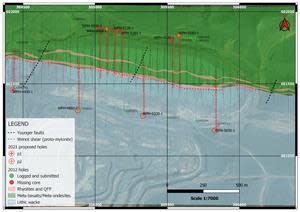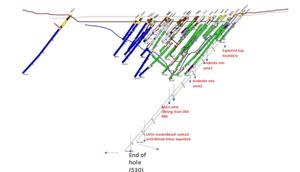Omai Gold Mines announces the start of drilling at the Omai Project
Figure 1

Plan map showing planned drill hole sites at historical Wenot Pit.
Figure 2

Cross section of first planned hole, OMDD21-001 looking west. Mafic rocks shown in green and sediments shown in blue.
TORONTO, Feb. 11, 2021 (GLOBE NEWSWIRE) -- Omai Gold Mines Corp. (TSX VENTURE:OMG) (“Omai” or the “Company”) is pleased to announce that the first phase of diamond core drilling at the Omai Project has commenced. The 5,000-meter drill program will focus on expanding the open-pit potential of the historical past-producing Wenot Pit. Wenot was not fully tested due to a low gold price environment, but previous drilling demonstrates the potential for similar grades and thicknesses of gold extending below the current pit, including 69 meters of 3.96 grams per tonne gold in hole OM-0412.
Highlights of the drill program:
An initial 5,000 meters of drilling has been planned below the Wenot Pit.
This drilling, combined with the logging and assaying of 6,000 meters of historical core, is expected to accelerate a new mineral resource estimate planned in late 2021.
Environmental baseline, metallurgy, and hydrology studies are expected to commence in the first quarter of 2021.
Historical data and geophysics along with new geologic modelling suggest multiple relatively untested targets for evaluation by trenching and drilling on the license.
Mario Stifano, Chief Executive Officer of Omai Gold Mines, commented: “We are very excited to kick off our initial 5,000 metres of drilling, especially after extending mineralization 150 meters below the historical pit with multiple high-grade assays, including 9.1 grams per tonne gold over 14 meters, as part of our program of logging and sampling of 6,000 meters of unassayed, recovered historical core. We look forward to testing the extent of gold mineralization below Wenot and reporting on our results in the coming months.”
The potential drill sites are based on a review of the historical drill database by Dr. Michael Gustin of MDA Associates in Reno, Nevada, a former exploration manager at Omai in the early 2000s; Dr. Linda Heesterman, a former exploration manager for Iamgold; and Dr. Dennis LaPoint, Omai’s Vice President of Exploration. Songela, a well-established Guyanese company, is the drilling contractor. A single rig with two shifts will initially be deployed.
Assay results received to date from core drilled in 2012 and subsequently sampled by Omai demonstrate that the Wenot grades and thicknesses from historical mining continue below the Wenot Pit with mineralization extended 100 to 150 meters below the historical pit, and remains open to depth (for more information, see Omai’s news release on February 9, 2021).
In addition, logging and assays extend the mineralization to the south in the sedimentary rocks, potentially expanding the width of the Wenot mineralization. The combination of logging of the 2012 drilling plus the creation of a new geological model which includes historical drill information and blast hole data, has correlated two high-grade mineralized zones that extend the entire length of the Wenot Pit. Dioritic dikes are not as well described in historical logs, but are also associated with high-grade mineralization, especially in sedimentary rocks to the south.
Logging of the 2012 drill core has led to a better understanding of the geology under the historical Wenot Pit. In the southern domain of the pit, a lithic wacke unit is dominant. This is a fine- to medium-grained immature sandstone. The contact between the lithic wacke and the basalts (to the north) consists of a highly strained unit with a proto-mylonite forming within the less competent lithic wacke. This structure, known as the Wenot shear, can be recognized in the drill holes by increased alteration and strain towards this contact and felsic dikes. North of the Wenot shear are chloritized basalt (green, aphantic) with a stratification of massive basalts/andesites and a more pillowed basalt sequence to the north. These are followed by andesite/basalt packages again.
Dikes of both felsic and dioritic composition intrude these units and are directly correlated with high-grade mineralization. The intrusive lithologies include:
Rhyolites, which are usually intensely silicified with considerable potassium alteration halos.
Quartz-feldspar porphyries, with quartz eyes and feldspar phenocrysts within an aphanitic siliceous matrix.
Quartz diorites, a phaneritic crystalline felsic greyish grey rock.
Hornblende diorites, crystalline rock with interlocking grains of quartz and feldspar crystals interlocked with fine-grained dark green amphibole.
Proximal to the intrusives, in the lithic wacke and the basaltic rocks, brittle-ductile deformation increases together with alteration and dikes. Apparent, shallow, north dipping (30º) extensional veins and some minor shear veins with associated sulfides dominate the structural component of the gold-bearing zones.
Figure 1: Plan map showing planned drill hole sites at historical Wenot Pit.
https://www.globenewswire.com/NewsRoom/AttachmentNg/fd771843-79e3-43f4-99b7-159aee8e3079
Figure 2: Cross section of first planned hole, OMDD21-001 looking west. Mafic rocks shown in green and sediments shown in blue.
https://www.globenewswire.com/NewsRoom/AttachmentNg/33a2e690-727f-4dfc-a638-168479029a0d
Watch a short video of drilling commencing at site: https://youtu.be/VfGu5Xufh6s
Sample collection, assaying and data management
An experienced technician is stationed at the rig for hole recovery, core orientation, and related geotechnical parameters. Core samples will be collected at 1- to 2-meter intervals for assaying and consist of ½ core. Standards, blanks and duplicates will be entered at regular intervals. Samples are sealed in plastic bags and shipped to the Actlabs certified laboratory in Georgetown, Guyana, respecting the best chain of custody practices. At the laboratory, samples are dried, crushed up to 80% passing 2 mm, riffle split (250 g), and pulverized to 95% passing 105 μm, including cleaner sand. 30 g of pulverized material is then fire assayed by atomic absorption (AA). Initial assays with results above 3,000 ppb gold are re-assayed with gravimetric finish. Standards and blanks are with QA/QC specifications.
Qualified Person
Dr. Dennis LaPoint, PhD, LGeo, is a Qualified Person (QP) under National Instrument 43-101 “Standards of Disclosure for Mineral Projects” and has approved the technical information contained in this news release. Dr. LaPoint is not considered to be independent for the purposes of National Instrument 43-101.
Neither the TSX Venture Exchange nor its Regulation Services Provider (as that term is defined in the policies of the TSX Venture Exchange) accepts responsibility for the adequacy or accuracy of this release.
About Omai Gold Mines Corp.
Early prospectors identified Guyana’s vast mineral wealth 130 years ago, and at the heart of the country’s gold mining history is the Omai mine: a multi-million-ounce deposit that was once South America’s largest producing gold mine. We’re building on this past success with new tools, relationships and vision to bring this under-explored gold district back to life, providing a unique opportunity for all stakeholders to participate in value creation.
Avalon Gold Exploration Inc., a wholly owned subsidiary of Omai Gold Mines Corp., holds a 100% interest in the Omai Prospecting License covering 4,590 acres, including the past producing Omai gold mine.
For further information, please see our website www.omaigoldmines.com or contact:
Mario Stifano
President and Chief Executive Officer
info@omaigoldmines.com
Cautionary Note Regarding Forward-Looking Statements
This news release includes certain “forward-looking statements” under applicable Canadian securities legislation. Forward-looking statements include, but are not limited to, statements with respect to results of the drill program; a mineral resource estimate planned in late 2021; and commencement of environmental baseline, metallurgy, and hydrology studies. Forward-looking statements are necessarily based upon a number of estimates and assumptions that, while considered reasonable, are subject to known and unknown risks, uncertainties and other factors which may cause the actual results and future events to differ materially from those expressed or implied by such forward-looking statements. Such factors include, but are not limited to: general business, economic, competitive, political and social uncertainties; delay or failure to receive regulatory approvals; the price of gold and copper; and the results of current exploration. There can be no assurance that such statements will prove to be accurate, as actual results and future events could differ materially from those anticipated in such statements. Accordingly, readers should not place undue reliance on forward-looking statements. The Company disclaims any intention or obligation to update or revise any forward-looking statements, whether as a result of new information, future events or otherwise, except as required by law.

 Yahoo Finance
Yahoo Finance 